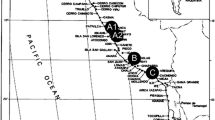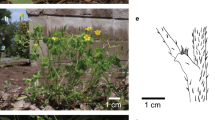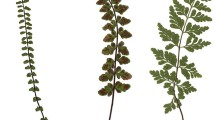Abstract
Natural F1 hybrids between the outcrossingPhlox drummondii and the predominantly selfingP. cuspidata were examined to ascertain the proportion of hybrid individuals mothered by each species. Species-specific restriction fragment patterns (both nrDNA and cpDNA) were established as markers, and synthetic hybrids of known parentage were utilized to determine that the chloroplast genome is maternally inherited. Of 89 mature natural hybrids examined, approximately two thirds were mothered byP. drummondii, the outcrosser. That the outcrosser should mother most hybrids is expected since it is dependent upon incoming pollen for fertilization, and hybrids may result when heterospecific pollen is received. The fact that the highly selfingP. cuspidata mothered nearly one third of the hybrids is surprising, and may be related to both pre-zygotic and post-zygotic factors. Which species mothers hybrids has important implications for the potential for introgression as well as its direction.
Similar content being viewed by others
References
Anderson E. (1949) Introgressive hybridization. Wiley, New York.
Arnold M. L. (1992) Natural hybridization as an evolutionary process. Annual Rev. Ecol. Syst. 23: 237–261.
Corriveau J. L., Coleman A. W. (1988) Rapid screening method to detect potential biparental inheritance of plastid DNA and results for 200 angiosperm species. Amer. J. Bot. 75: 1445–1458.
Cruzan M. B., Arnold M. L., Carney S. E., Wollenberg K. R. (1993) cpDNA inheritance in interspecific crosses and evolutionary inference in Louisiana irises. Amer. J. Bot. 80: 344–350.
De Nettancourt D. (1977) Incompatibility in angiosperms. Springer, Berlin Heidelberg New York.
Doyle J. J., Doyle J. L. (1987) A rapid DNA isolation procedure for small quantities of fresh leaf tissue. Phytochem. Bull. 19: 11–15.
Edwards-Burke M. A., Hamrick J. L., Price R. A. (1997) Frequency and direction of hybridization in sympatric populations ofPinus taeda andP. echinata (Pinaceae). Amer. J. Bot. 84: 879–886.
Ellstrand N. C., Whitkus R., Rieseberg L. H. (1996) Distribution of spontaneous hybrids. Proc. Natl. Acad. Sci. USA 93: 5090–5093.
Erbe L., Turner B. L. (1962) A biosystematic study of thePhlox cuspidata — Phlox drummondii complex. Amer. Midl. Naturalist 67: 257–281.
Grant V. (1956) The genetic structure of races and species inGilia. Advances Genet. 8: 55–87.
Grun P. (1976) Cytoplasmic genetics and evolution. Columbia University Press, New York.
Harder L. D., Cruzan M. B., Thomson J. D. (1993) Unilateral incompatibility and the effects of interspecific pollination forErythronium americanum andErythronium albidum (Liliaceae). Canad. J. Bot. 71: 353–358.
Harper J. L., McNaughton I. H. (1960) The inheritance of dormancy in inter- and intraspecific hybrids ofPapaver. Heredity 15: 315–320.
Harris S. A., Ingram R. (1991) Chloroplast DNA and biosystematics: the effects of intraspecific diversity and plastid transmission. Taxon 40: 393–412.
Harrison B. J., Darby L. A. (1955) Unilateral hybridization. Nature 176: 982.
Hiscock S. J., Dickinson H. G. (1993) Unilateral incompatibility within theBrassicaceae: further evidence for the involvement of the self-incompatibility (S)-locus. Theor. Appl. Genet. 86: 744–753.
Levin D. A. (1967) Hybridization between annual species ofPhlox: population structure. Amer. J. Bot. 54: 1122–1130.
Levin D. A. (1975a) Interspecific hybridization, heterozygosity and gene exchange inPhlox. Evolution 29: 37–51.
Levin D. A. (1975b) Minority cytotype exclusion in local plant populations. Taxon 24: 35–43.
Levin D. A. (1976) Consequences of long-term artificial selection, inbreeding, and isolation inPhlox: I. The evolution of cross-incompatibility. Evolution 30: 335–344.
Levin D. A. (1978) Genetic variation in annualPhlox: self-compatible vs. self-incompatible species. Evolution 32: 245–263.
Lewis D., Crowe L. K. (1958) Unilateral interspecific incompatibility in flowering plants. Heredity 12: 233–256.
Linder C. R., Taha I., Seiler G. J., Snow A. A., Rieseberg L. H. (1998) Long-term introgression of crop genes into wild sunflower populations. Theor. Appl. Genet. 96: 339–347.
Milligan B. G. (1992) Is organelle DNA strictly maternally inherited? Power analysis of a binomial distribution. Amer. J. Bot. 79: 1325–1328.
Nason J. D., Ellstrand N. C., Arnold M. L. (1992) Patterns of hybridization and introgression in populations of oaks, manzanitas, and irises. Amer. J. Bot. 79: 101–111.
Olmstead R. G., Palmer J. D. (1992) A chloroplast DNA phylogeny of theSolanaceae: subfamilial relationships and character evolution. Ann. Missouri Bot. Gard. 79: 356–360.
Palmer J. D. (1986) Isolation and structural analysis of chloroplast DNA. Meth. Enzymol. 118: 167–186.
Rieseberg L. H., Ellstrand N. C. (1993) What can molecular and morphological markers tell us about plant hybridization? C. R. C. Crit. Rev. Pl. Sci. 12: 213–241.
Rieseberg L. H., Linder C. R., Seiler G. J. (1995) Chromosomal and genic barriers to introgression inHelianthus. Genetics 141: 1163–1171.
Rieseberg L. H., Whitton J., Linder C. R. (1996) Molecular marker incongruence in plant hybrid zones and phylogenetic trees. Acta Bot. Neerl. 45: 243–262.
Saghai-Maroof M. A., Soliman K. M., Jorgensen R. A., Allard R. W. (1984) Ribosomal DNA spacer-length polymorphisms in barley: Mendelian inheritance, chromosomal location, and population dynamics. Proc. Natl. Acad. Sci. USA 81: 8014–8018.
Sambrook J., Fritsch E. F., Maniatis T. (1989) Molecular cloning, a laboratory manual, 2nd edn. Cold Spring Harbor Laboratory Press, New York.
Smith D. M., Levin D. A. (1967) Karyotypes of eastern North AmericanPhlox. Amer. J. Bot. 54: 324–334.
Watkins L., Levin D. A. (1990) Outcrossing rates as related to plant density inPhlox drummondii. Heredity 65: 81–89.
Wherry E. T. (1955) The genusPhlox. Morris Arbor. Mongr. III, Philadelphia.
Whitehouse E. (1945) AnnualPhlox species. Amer. Midl. Naturalist 34: 388–401.
Author information
Authors and Affiliations
Corresponding author
Rights and permissions
About this article
Cite this article
Ferguson, C.J., Levin, D.A. & Jansen, R.K. Natural hybridization between an outcrossing and a selfingPhlox (Polemoniaceae): The maternal species of F1 hybrids. Pl Syst Evol 218, 153–158 (1999). https://doi.org/10.1007/BF01087043
Received:
Accepted:
Issue Date:
DOI: https://doi.org/10.1007/BF01087043




